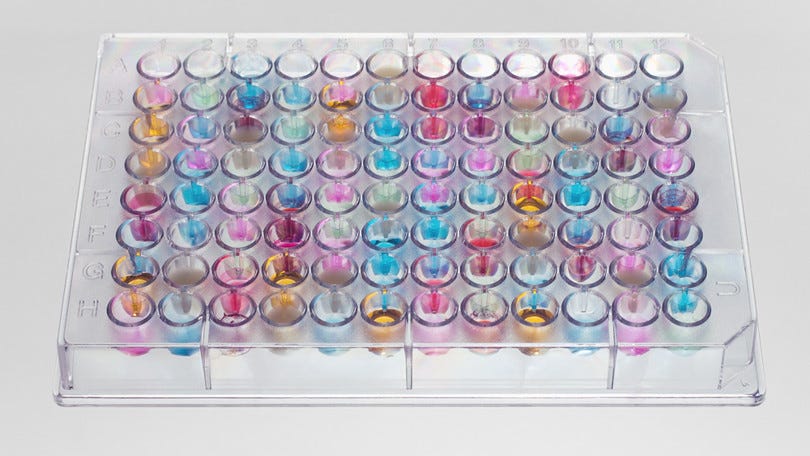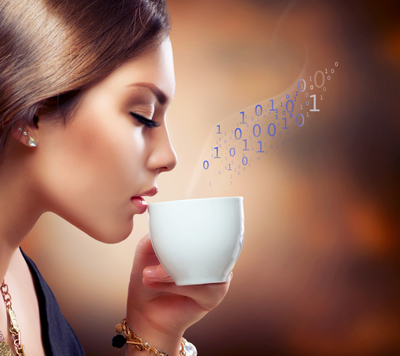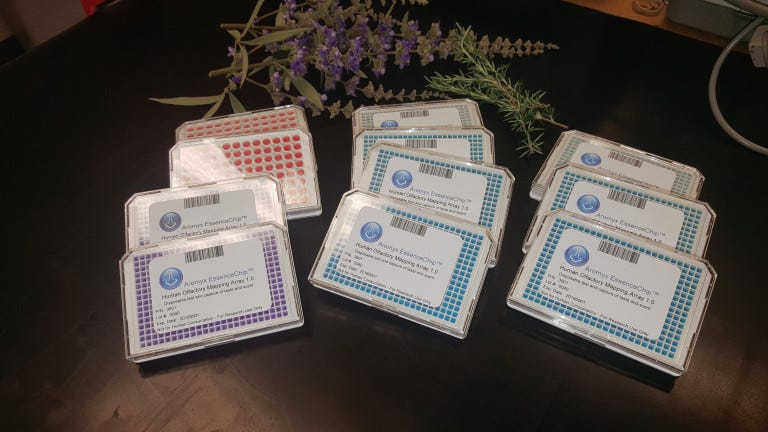Aromyx Makes Chips That Can ‘Digitize’ Taste and Smell
Aromyx Makes Chips That Can ‘Digitize’ Taste and Smell


CEO Chris Hanson explains how that might one day translate into a smartphone chip that can detect a change in health or identify a new virus.
Imagine this: It’s 5 a.m. on March 9, 2028. You’re in Hong Kong, heading to the airport for an early flight back to the US. Your android hotel assistant takes your luggage to an autonomous car at the curb. As the back door of the vehicle opens, you’re greeted by a refreshing aroma of citrus, with a dash of caffeine.
This scientifically preps your mind and body to wake up gently (because you quit drinking actual coffee for health reasons back in 2022). Alert now, you lean back as the car reads you your urgent messages while dialing your boss in Chicago (it’s still 4 p.m. Wednesday back there) for a video call from your seat.
As you approach the airport, the aroma changes. You don’t notice it because it’s so subtle, hitting the emotional and memory regions of the brain first. It informs your onboard meal choices; you select the non-dairy vegan option, not knowing that if the car had pumped in the aroma of a synthetic buttery croissant, you’d have made a different choice.
How’s Your Health?
Once you’ve done that, using the dashboard plasma screens, the AI inside the vehicle notes the transaction and switches to “pharma” mode. It’s been analyzing your breath output and knows you’re low on B12 and D3 (you’ve been inside a conference room for days and haven’t seen sunlight).
A glass appears in the console and a spout pours in a clear liquid. You drink the chemical cocktail, and it mitigates the effects of hard living and brutal work patterns. This is personalized medicine at its best.
Just as the vehicle pulls up to the gate, bypassing security (immigration checks are done inside the locked vehicle for private transit passengers; your stuff was also scanned inside the trunk), you remember you’ve got your children this weekend and completely forgot to buy gifts.
What you don’t know is that the aroma switched to a chemical compound that promotes commerce behavior about two seconds ago. You turn to the dashboard, do a single-click checkout of its suggestions for nerdy teens who play digital chess, and walk up to the plane.
And Now for the Science Bit
This is a probable future engineered by the artificial intelligence inside Aromyx’s Palo Alto labs.
I went there recently to meet CEO Chris Hanson for a tour. Inside are a bunch of very cool-looking machines. There are E.coli cultures expressing the human protein inside an incubator shaker for testing; centrifuges to isolate the proteins; bottles of “food” for bacteria and yeast; microplate readers; and trays of empty Aromyx EssenceChips waiting to be populated with specimens.
Stanford-educated Hanson has worked in military intelligence for the US Army, at the National Security Agency as a computational linguist specializing in natural language processing, and as a foreign service officer in Moscow for the Department of State. He’s also held positions at Seagate, IBM, and several startups before landing at Aromyx in 2012. Here are edited and condensed excerpts from our conversation:
Chris, what are you doing that’s revolutionary in this space of sensory AI?I’ve had a bunch of experience in my past that drove me to this point of trying to apply technology to smell and taste, including projects funded by DARPA. The search for a wideband multi-analyte chemical sensor turned out to be pretty difficult, but we believe its time has come. We started planning and thinking about Aromyx as far back as 2004. Taste and smell are the last senses to be digitized. It’s also a really interesting field of science research.


Can you explain exactly how you ‘digitize’ these senses?We are essentially taking the biochemical stack out of the human [nose and tongue] that allows us to smell and taste the world by pulling DNA from a pool of individuals and identifying each receptor. It looks like the nose and tongue detect a billion or more chemicals, down to parts per trillion sensitivity. We clone this biochemical stack into a standard SBS well plate format.
You’re growing virtual noses?In a way, yes. We pop the DNA/biochemical stack into a live yeast cell. The cell then acts as a virtual machine and reads the instruction set, creating the physical human olfactory receptor in the yeast membrane. The way it becomes jammed into the yeast cell membrane means that part of it sticks outside the membrane so it can “smell” Chanel №5 or, say, Coca-Cola. It’s a sensor construct.
Wow. You are building virtual organs. Right here in this lab. Right [laughs]. Then we do that 402 times to represent the entire olfactory repertoire. An odorant molecule then binds with the receptor, and there’s a chemical cascade that happens within the cell which, ultimately, can be read, on one of our EssenceChips, by the plate reader. Our machine learning software then interprets these signals, identifying the substance corresponding to a given activation pattern for instance.


Let’s talk about some of its potential uses. Can it be used to identify the chemical compound of explosives to trace terrorist cells? Are you still working with the DoD?We’ve got the tech in the lab which is good at detecting things like mustard gas, and at some point, the technology could be used for that kind of chemical detection. But it’s not the market that we want to pursue. We might want to license it to others under a SaaS model. There are some markets like the IED [improvised explosive device] or contraband detection fields, but I don’t want to be there anymore. I was in it before and you end up with the US government as your only customer. The margins are cut-throat, plus you have to work with chemicals like TNT. To be honest, I’d rather work with Chanel №5.
I can see the appeal.Our original idea was to work with the beverage, consumer packaged goods, and chemical companies — essentially, anyone who makes a product where the essential quality is taste and/or smell. The idea was to offer them technology that would help them create new products that had a much higher chance of success, because we’d already digitally identified the taste/smell that is highly pleasurable to humans. Another big use is reformulation. The demand for soda beverages has dropped off a cliff because people are worried about their health but they still love the taste of, say, Coca Cola. So if you could reformulate it with the same flavor but with, I don’t know, something benign — like chamomile, honey, and pine nuts — maybe people would buy it again.
Chanel currently relies on gifted humans as ‘noses.’ They just hired Olivier Polge. Have you been approached by Chanel, or their competitors, to find an AI to replace Polge and his fellow noses?We have contacts with all the fragrance companies and several of the family offices. But our impression is that they are Kodak circa 1990.
Ouch. Do explain.They don’t seem to understand where the market is going. They will be left behind. Just like when Kodak refused to see the writing on the wall with digital cameras and cameras inside phones, the perfume and beverage companies don’t realize that technology like ours that digitizes taste and smell means their customers can take what they’ve been doing in their labs in a traditional way and replicate it very cheaply on a laptop at home.
What other industry verticals have you approached? We’re deep in conversations with the automotive industry. Car companies source their parts from all over, by fit and finish, engineering specs, and cost, but never by smell. No one pays attention to that, and often the parts smell bad, [so] you end up with a car that you can’t sit in without getting nauseated. So that’s one scenario for us.
Giving new cars the smell test?Right. Otherwise, they can’t sell them. But I’m more interested in the future use, which is in autonomous vehicles, when — as car companies say — people become passengers, not drivers. They’re building shopping portals into their dashboard displays and they want to manipulate people into buying stuff.
Just like the supermarkets that pump in freshly baked bread smell?It started with casinos. We know Dr. Alan Hirsch, the academic who, back in the day, did the first casino study, changing the aromas around banks of slots and was able to significantly increase gambling behavior. This is now standard practice in retail environments and we’d like to bring it to automation for the car companies.
In a more save-the-world vein, might your tech also stop global viruses in their track by identifying aromas to show someone is infected? We have several key advisors on our board, including Rhonda Wallen, biotech adviser and former CEO of a cancer therapies pharma company, and IBM’s Dr. James Kaufman, who currently works on the Spatiotemporal Epidemiological Modeler (STEM) project. We think that identifying global pandemics is a really promising area. The dream is to get the EssenceChip to fit in your phone so it can detect a change in health or identify a new virus. Many diseases have a known biomarker, so we could detect its presence via the breath and issue an alert.
Hello, you’ve got mail — and cancer.Hopefully, it would just tell you to see your doctor — like now, don’t wait for the next check-up.
How would you get the EssenceChip into a phone?First, we’d have to go from this wet substrate to a dry substrate, a silicon chip that can be made in the tens of millions and go into every smartphone. With a smartphone, we wouldn’t have to change anyone’s behavior, because we hold the phone up to our breath all day long. So often, with technology, you can have a cool idea — Silicon Valley is full of them — but they’re not able to get the prospective customer to change their behavior.
Do you see a commercial product for consumers in your pipeline?Yes, I do. We have aromagraphs for many different scents. For example, there’s a particular wine that I like, but it’s pricey. I’d like to use our aroma-graphs to suggest a different wine with a similar scent profile. We have a dashboard to help us do this; it’s going through several iterations but it’s a good visual receptor representation of different olfactory senses. There are a bunch of wine apps for smartphones that exist already, so we could incorporate our tech, through licensing, into an existing app. We see this as very profitable from a SaaS business licensing model perspective.
